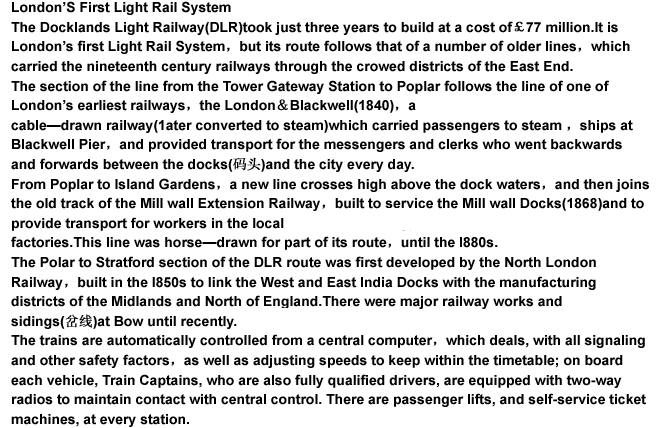 题目内容
(请给出正确答案)
题目内容
(请给出正确答案)
London's First Light Rail System The Docklands Light Railway (DLR) took just three years t
London's First Light Rail System
The Docklands Light Railway (DLR) took just three years to build at a cost of £77 million. It is London's first Light Rail System, but its route follows that of a number of older lines, which carried the nineteenth century railways through the crowded districts of the East End.
The section of the line from the Tower Gateway Station to Poplar follows the line of one of London's earliest railways, the London & Blackwell (1840), a cable-drawn railway (later converted to steam) which carried passengers to steam ships at Blackwell Pier, and provided transport for the messengers and clerks who went backwards and forwards between the docks (码头) and the city every day.
From Poplar to Island Gardens, a new line crosses high above the dock waters, and then joins the old track of the Millwall Extension Railway, built to service the Millwall Docks (1868) and to provide transport for workers in the local factories. This line was horse-drawn for part of its mute, until the 1880s.
The Poplar to Stratford section of the DLR route was first developed by the North London Railway, built in the 1850s to link the West and East India Docks with the manufacturing districts of the Midlands and North of England. There were. major railway works and sidings (岔线) at Bow until recently.
The trains are automatically controlled from a central computer, which deals with all signaling and other safety factors, as well as adjusting speeds to keep within the timetable; on board each vehicle, Train Captains, who are also fully qualified drivers, are equipped with two-way radios to maintain contact with central control. There are passenger lifts, and self-service ticket machines, at every station.
The passage tells us that London's first Light Rail System ______
A.was constructed in the nineteenth century.
B.will be finished in three years' time.
C.follows some of the original lines.
D.took three years longer than expected to complete.
 如果结果不匹配,请 联系老师 获取答案
如果结果不匹配,请 联系老师 获取答案


 更多“London's First Light Rail Syst…”相关的问题
更多“London's First Light Rail Syst…”相关的问题



















